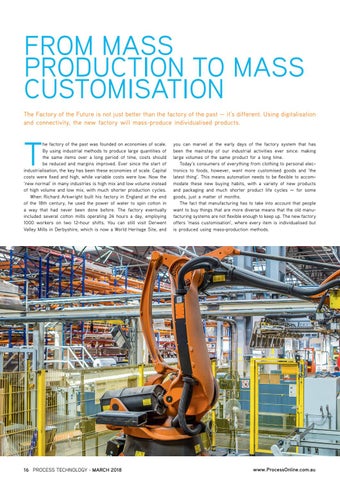FROM MASS PRODUCTION TO MASS CUSTOMISATION The Factory of the Future is not just better than the factory of the past — it’s different. Using digitalisation and connectivity, the new factory will mass-produce individualised products.
T
he factory of the past was founded on economies of scale. By using industrial methods to produce large quantities of the same items over a long period of time, costs should be reduced and margins improved. Ever since the start of industrialisation, the key has been these economies of scale. Capital costs were fixed and high, while variable costs were low. Now the ‘new normal’ in many industries is high mix and low volume instead of high volume and low mix, with much shorter production cycles. When Richard Arkwright built his factory in England at the end of the 18th century, he used the power of water to spin cotton in a way that had never been done before. The factory eventually included several cotton mills operating 24 hours a day, employing 1000 workers on two 12-hour shifts. You can still visit Derwent Valley Mills in Derbyshire, which is now a World Heritage Site, and
16 PROCESS TECHNOLOGY - MARCH 2018
you can marvel at the early days of the factory system that has been the mainstay of our industrial activities ever since: making large volumes of the same product for a long time. Today’s consumers of everything from clothing to personal electronics to foods, however, want more customised goods and ‘the latest thing’. This means automation needs to be flexible to accommodate these new buying habits, with a variety of new products and packaging and much shorter product life cycles — for some goods, just a matter of months. The fact that manufacturing has to take into account that people want to buy things that are more diverse means that the old manufacturing systems are not flexible enough to keep up. The new factory offers ‘mass customisation’, where every item is individualised but is produced using mass-production methods.
www.ProcessOnline.com.au
